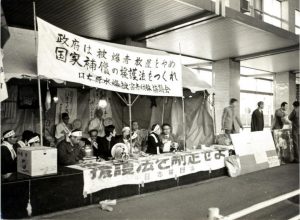Nihon Hidankyo’s path to Nobel Peace Prize, Part 2: Demanding support for A-bomb survivors
Dec. 2, 2024
Starting point, “Restore Hiroshima as it was”
National government compensation seen as path to nuclear abolition
by Fumiyasu Miyano, Staff Writer
In 1956, economic white papers proclaimed, “It is no longer the post-war period.” However, support from the national government had not yet reached survivors of the atomic bombings. In September, one month after its founding, the Japan Confederation of A- and H-Bomb Sufferers Organizations (Nihon Hidankyo) held a meeting with its representatives and board of directors to discuss a draft outline for the Atomic Bomb Survivors Relief Law Bill. The bill outline included such measures as full payment by the national government of medical expenses for A-bomb survivors, health management at government expense, payment of condolence money for victims, and establishment of a pension system for bereaved families.
Against the backdrop of the calls made by A-bomb survivors and the movement to ban atomic and hydrogen bombs, the Japanese government was also considering measures for A-bomb survivors. Heiichi Fuji, the first secretary-general of Nihon Hidankyo who died in 1996, worked tirelessly for the bill, receiving support from a student in a lower grade at their middle school affiliated with the Hiroshima Higher Normal School (present-day Hiroshima University Junior and Senior High School) who worked at Japan’s Ministry of Finance at the time. In 1957, the Atomic Bomb Medical Relief Law was enacted, leading to the issuance of Atomic Bomb Survivor’s Certificates and implementation of twice-yearly health examinations for survivors.
While Mr. Fujii appreciated that first law for the A-bomb survivors, he believed their “problems would not be resolved until all relevant laws are fully implemented.” In Hiroshima’s local dialect, he would proclaim, “Restore Hiroshima as it was.”
In 1966, Hidankyo published a document titled “Characteristics of A-Bomb Damage and Demands for Atomic Bomb Survivors Relief Law” (also known as the ‘Tsuru Brochure’), which questioned the government’s responsibility for the war and demanded national compensation. In 1968, the A-bomb Survivors Special Measures Law was enacted. The law included provision of benefits to survivors. Nihon Hidankyo, however, considered the law to be insufficient because it did not stipulate payment of condolence money for deceased victims of the atomic bombings.
All-night, sit-in demonstration
In April 1973, after it organized necessary support measures, Nihon Hidankyo released an outline of its demands. Teruko Yokoyama, 83, who served as a staff member in the secretariat of the Nagasaki Atomic Bomb Survivors Council, traveled to Tokyo by night train to participate in deliberations. Ms. Yokoyama’s mother had died from stomach cancer, her father’s thyroid was not in good health, and her younger sister was frequently in and out of the hospital. As their medical expenses were taking a toll on their daily life, she had no choice but to engage in the A-bomb survivor movement.
Ms. Yokoyama was inspired by compatriots who gathered from all over Japan to demand not only “compensation for damages” or “livelihood security” but also “future guarantees” that the tragedy of the atomic bombings would never happen again. It was an eye-opening experience for her because she realized that, “The Nihon Hidankyo movement was not just about seeking money for us. We were also willing to risk our own lives.”
In November 1973, Nihon Hidankyo, setting forth the outline of its demands, staged an all-night, sit-in demonstration over the course of five days after setting up tents in front of Japan’s Ministry of Health and Welfare. The demonstrators were provided sustenance including miso soup with pork and onigiri rice balls, as well as encouragement from the novelist Kenzaburo Oe, who died in 2023. Ms. Yokoyama, who saw off the survivors in Nagasaki for the demonstration, looked back at the experience. “Everyone was firmly resolved to join the sit-in even if it meant being imprisoned,” she explained.
The government continued to resist expansion of the scale of support for survivors and victims of the atomic bombings. In 1980, in addition to the argument for equality with ordinary war victims, the Ministry of Health and Welfare’s private advisory panel Conference for Fundamental Problems of Measures for the Victims of the Atomic Bombs (Kihon-kon) suggested that all Japanese citizens must equally endure war damages.
Fierce protest against tolerance theory
Nihon Hidankyo protested fiercely against the so-called “tolerance theory,” saying “it would mean that the victims died for nothing.” During the period 1983–1984, the organization surveyed 3,690 A-bomb survivors and confirmed they shared the hope that “no other A-bomb survivors should ever be created.” Nihon Hidankyo members held repeated deliberations on a national level about what should be done to realize that goal, leading to the release of the organization’s “Basic demands from A-bomb survivors.”
Numerous handwritten notes remain in the original draft of the demands from that time. Yoshie Kurihara, 77, a staff member in Nihon Hidankyo’s secretariat office who supported development of the draft, testified that, “The document was revised and rewritten more than 20 times.” It was said that the act of compensation for damages from the atomic bombings as a responsibility of the national government would be akin to a pledge to eliminate nuclear weapons. Nihon Hidankyo’s “Constitution of the movement,” which the organization formulated at the 28th anniversary of its foundation, is still solid. However, the movement to ban atomic and hydrogen bombs, which had been inseparable from Nihon Hidankyo during that period, is in dire straits.
(Originally published on December 2, 2024)








